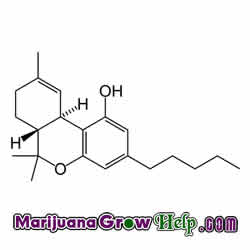From THC to CBD and CBN

The Role of THC
Although delta-9-tetrahydrocannabinol, more commonly known as THC, is certainly the most well-known cannabinoid contained within cannabis, it certainly is not the only cannabinoid. Cannabinoids are broad class of chemical compounds that bond to, or activate, cannabinoid receptors in the body (known as CB1 and CB2 receptors).
As scientists discovered when they first started trailing Marinol, it seems that there is a lot more to what makes cannabis such a potent medicinal plant than simple the THC content.
Now, THC is the cannabinoid that is most responsible for the psychoactive aspects of marijuana consumption and the general feeling of being high that accompanies cannabis consumption. But as patients who used Marinol found out, pure THC by itself isn’t always the most enjoyable medicine to use. Who would have guessed? Well, Nature knows best once again, because in marijuana you find THC bound up with a bunch of other awesome cannabinoids.
There are a lot of cannabinoids, terpenes, and other interesting, therapeutic compounds to be found in cannabis, but some of the best researched cannabinoids include:
- Cannabidiol also known as CBD is a cannabinoid that has been shown to have anti-cancer properties, among other potential health benefits. CBD has a mitigating effect on the psychoactive aspect of THC, taking the edge off the high feeling.
- Strains high in CBD are excellent for treating inflammation, anxiety, nausea, convulsions and even epilepsy. Research also indicates that CBD has potential for use as a powerful antipsychotic, suitable for use in treating schizophrenia.
- Cannabinol is also known as CBN and it has a very similar chemical profile to THC but it has milder psychoactive effects. When exposed to light, THC will start to break down and CBN is one of the compounds left behind. Although further study is certainly needed (and very much warranted) preliminary studies have shown that CBN may inhibit the growth and spread of cancer cells in animal tissue.
- Delta-9-Tetrahydrocannabinol, also known as THC is the most abundant cannabinoid in cannabis, and it is certainly the most psychoactive. Known for its stimulating effect on the appetite, it is useful as in the treatment of nausea and neuropathic pain, among other symptoms. Recent studies have also identified THC as a neuroprotective agent and potentially a potent anti-cancer agent.
- Other cannabinoids that have been identified but remain poorly studied include Cannabichromene or CBC, Cannabigerol or CBG, Cannabicyclol or CBL, and Cannabivarin or CBV
The way these various cannabinoids work on the human body is fascinating. Cannabinoids bind to the CB1 and CB2 receptors, and these receptors are located throughout the body, including packed into the brain, throughout the immune system, in the heart, liver, kidneys, spleen and lungs and deep within the bone marrow.
The two main cannabinoids that breeders tend to look for are THC and CBD.
Cannabis Sativa is known to generally contain lower levels of CBD and slightly higher THC content than Cannabis Indica. A sativa plant, for instance, may have 18 – 21% THC and only 2 -3% CBD content, whereas an indica is more likely to have a similar amount of THC, but will also have 10 – 15% CBD content. Naturally, the CB1 and CB2 receptors are activated by various substances that are produced within the human body. These naturally occurring cannabinoids are called endocannabinoids, whereas the cannabinoids found in marijuana and some other plants are known as phytocannabinoids, or plant-based cannabinoids.
Research to date has shown cannabis to have a broad spectrum of potential medicinal and therapeutic benefits, as countless patients who have used MMJ can attest to. Widely known for use among cancer and HIV patients, cannabis has shown to be a potent medicine for the relief of arthritis and other chronic inflammatory pain. Patients with multiple sclerosis and other neuropathic pain have also used cannabis to effect great relief.
Unfortunately, the continued prohibition and illegality of cannabis throughout the world has hindered proper research for many decades. A small handful of clinical trials have been published post-2000, but the illegality of cannabis continues to needlessly curtail further study.






No comments yet.